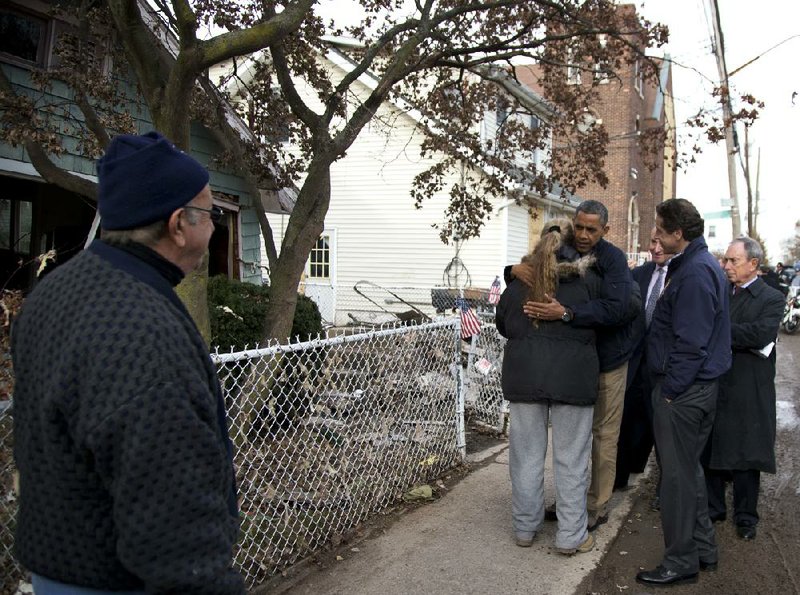NEW YORK — President Barack Obama said Thursday that he was assigning Shaun Donovan, the secretary of housing and urban development, to oversee the New York area’s long-term recovery from Hurricane Sandy.
“I’m very proud of you, New York,” the president said after meeting with emergency workers on Staten Island. “You guys are tough. You bounced back just as America always bounces back. The same is going to be true this time.”
Obama said he wanted federal officials to work with state and local leaders, both in New York and New Jersey, “to come up with a game plan for how we’re going to be able to resource the rebuilding process.”
“It’s going to require everybody to focus on getting the job done,” the president said. “We’re going to have to put some of the turf battles aside, we’re going to have to make sure everybody’s focused on doing the job as opposed to worrying about who’s getting the credit or who’s getting the contracts and all that stuff that sometimes goes into the rebuilding process.”
Obama toured Staten Island on a day of thin, almost hazy sun, a bright contrast to the ominous, slate-gray sky just before and just after the storm hurled a wall of water against the coast. He flew to John F. Kennedy International Airport and boarded a helicopter that took him over the Rockaway Peninsula and over Breezy Point, a waterfront community where 100 homes were destroyed in a fire. Some homes there now have plastic sheeting where roofs used to be.
Obama’s helicopter went on to Staten Island, where he landed at Miller Field, a former Army Air Corps installation that has become a center for efforts to rebuild from the storm.
The storm killed more than 100 people as it churned up the East Coast, with most of the deaths in low-lying sections of New York and New Jersey. But it exacted a particularly high toll on Staten Island. Of 43 deaths attributed to the storm in New York City, 23 were on Staten Island. But the storm also left millions without power and thousands in need of homes.
On Thursday, the president stopped at a federal disaster recovery center, where a group of about 200 residents cheered as he arrived. He chatted with the Staten Island borough president, James Molinaro, and other officials. Later he was expected to stop at a Small Business Administration tent and greet a line of disaster workers from FEMA Corps, an AmeriCorps program started in 2009. He also visited a food-distribution tent.
In the tent, the president shook hands and hugged some people. Some volunteers told him they were from Texas, others from West Virginia, others from other states.
“We got the whole country represented here,” the president said. “We’re proud of you guys.”
The president left the tent and encountered the police commissioner, Raymond Kelly.
“You’ve been busy,” the president told the commissioner after they exchanged handshakes and bear hugs.
Obama, with Gov. Andrew Cuomo and Sens. Charles Schumer and Kirsten Gillibrand, went on to shake hands and take photographs with residents who had gathered near the tents. But some Staten Islanders who had endured the storm said they were at best indifferent about his visit.
“I don’t care that he’s here,” said Steve Pasciak, 47, who was on his way to speak with insurance company representatives. “I mean, I think he’s done a good job. He responded quickly. He could’ve come to Staten Island sooner.”
Pasciak said a 3-foot wall of water had rushed through his house as the storm tore by; he said electricity and heat were not turned back on until Tuesday. He said he would not wait to see the president.
“I need to go back and start throwing stuff out,” he said. “I have a lot of work to do.”
After leaving the recovery center, Obama went to the nearby New Dorp neighborhood to visit with residents and deliver some remarks.
Obama had been expected to visit New York in the days after the storm struck Oct. 29, but Mayor Michael Bloomberg asked him not to come because he worried that the visit would be disruptive as the city took the first steps toward recovery. Obama toured the decimated New Jersey coast with Gov. Chris Christie, a visit infused with political overtones as the two put on a display of bipartisan harmony in the days before what was expected to be a close presidential election.
The trip comes less than 24 hours after Gillibrand and Schumer asked for up to $1 billion in federal aid to rebuild the coastline — more than 120 miles in all, from Rockaway Beach in Queens to Montauk Point, at the eastern end of Long Island.
Cuomo had earlier announced that he would request $30 billion in federal aid for storm-related expenses, including everything from repairing bridges, tunnels and subway lines to paying emergency workers’ overtime costs. The White House press secretary, Jay Carney, said aboard Air Force One on the way to New York that the administration had no specific response because it had not received details of the request.
Meanwhile, Gov. Dannel Malloy said Thursday that while the cost of the damage to Connecticut businesses, homes and public properties from last month’s superstorm is an estimated $360 million and climbing, it doesn’t amount to “a long-term hit to our economy.”
Information for this article was contributed by John Christoffersen and Susan Haigh of The Associated Press.
Front Section, Pages 4 on 11/16/2012
